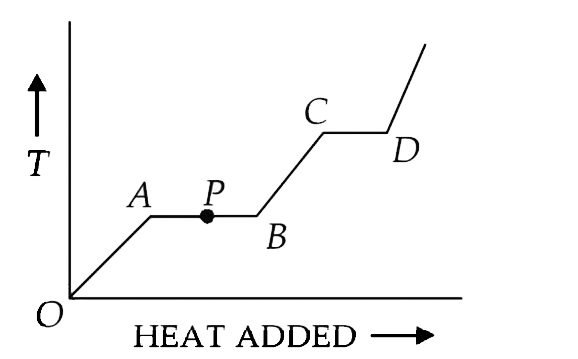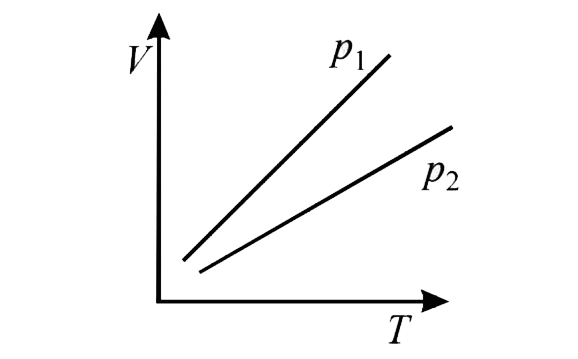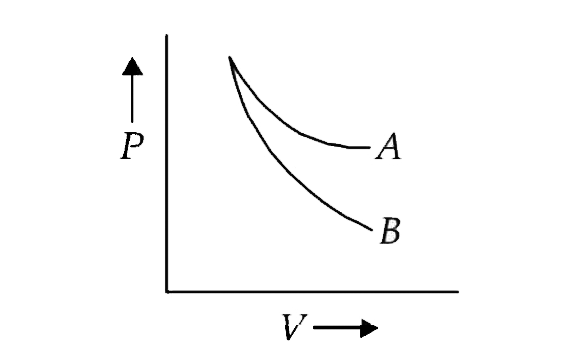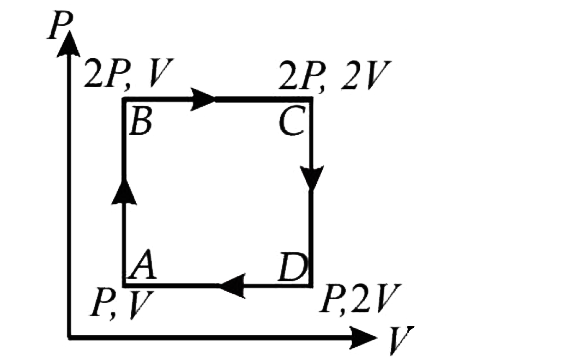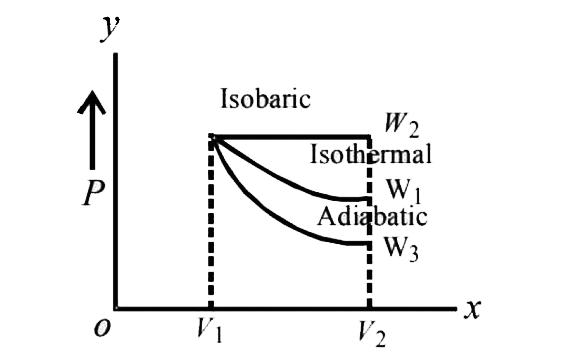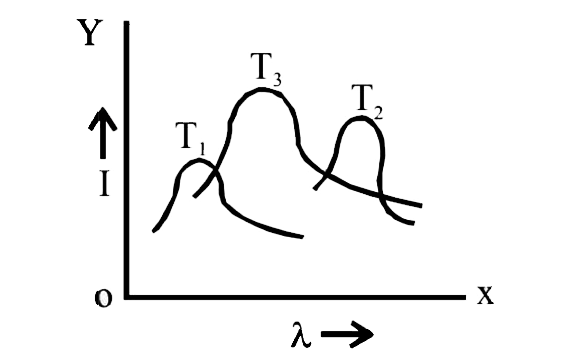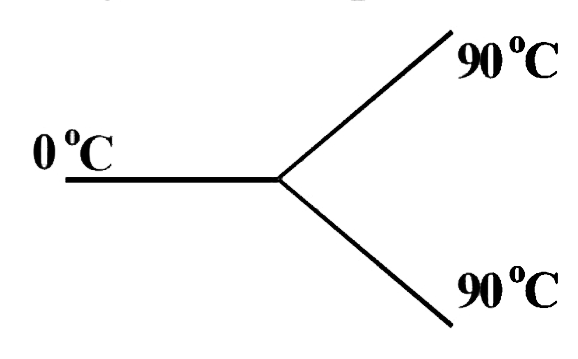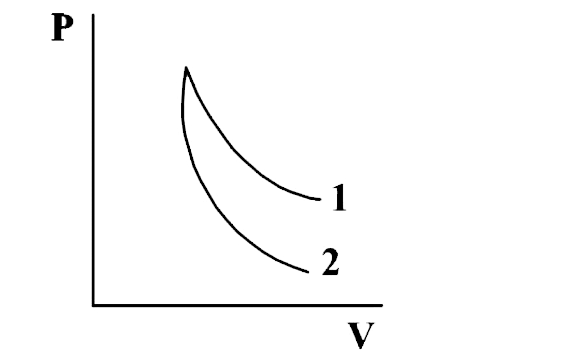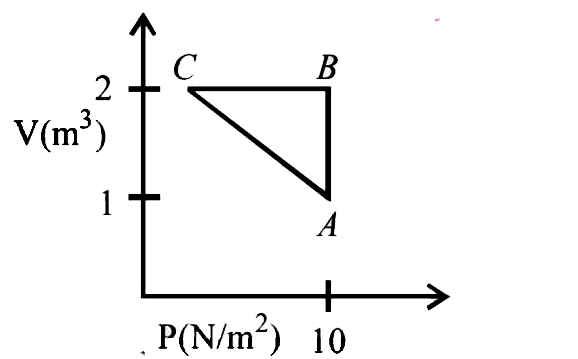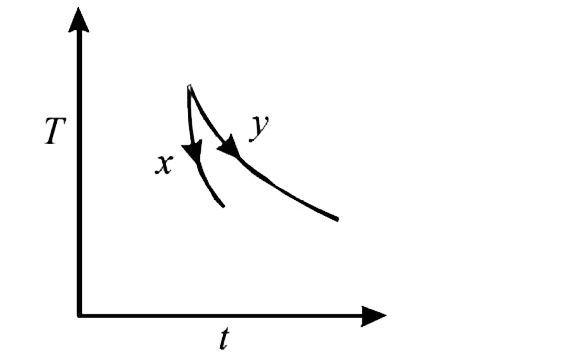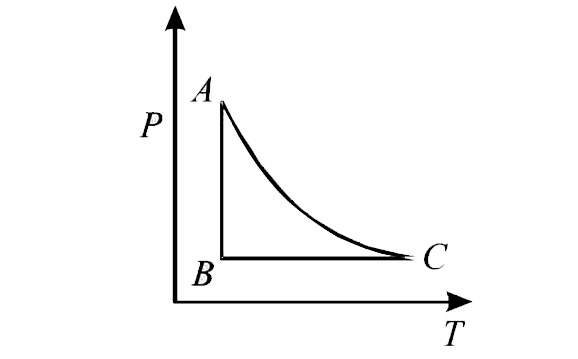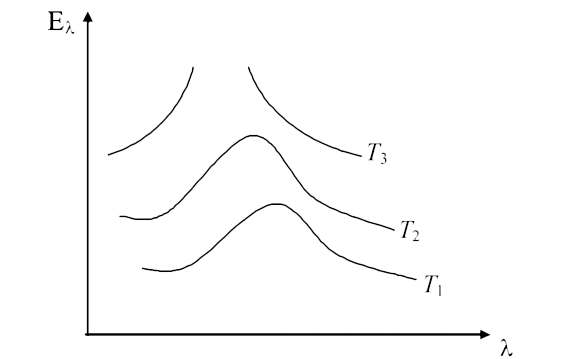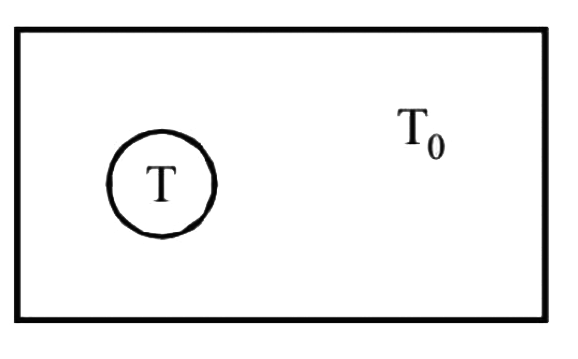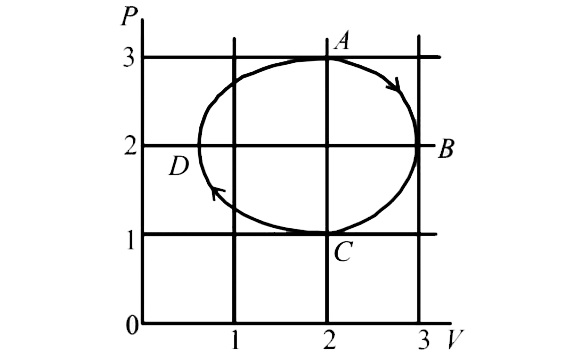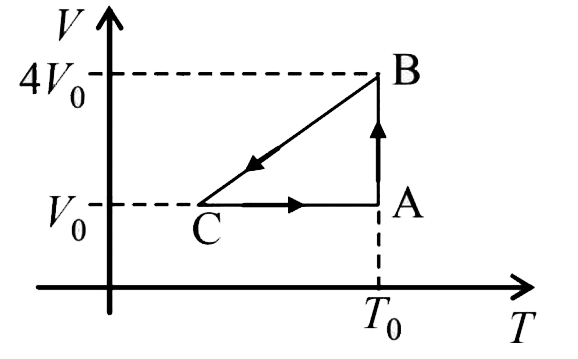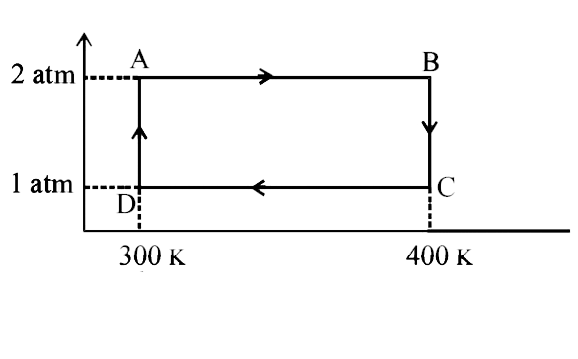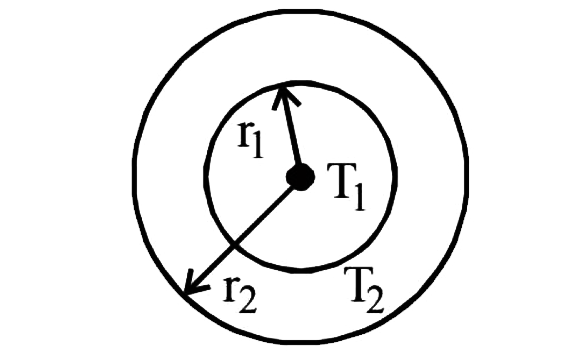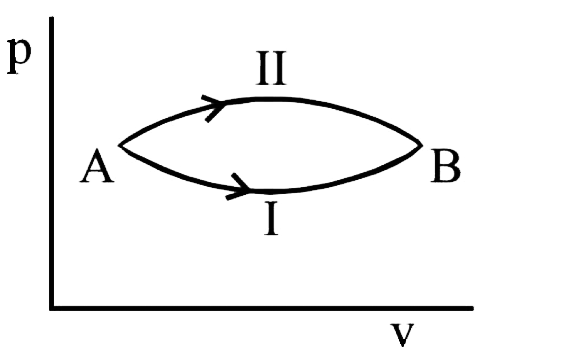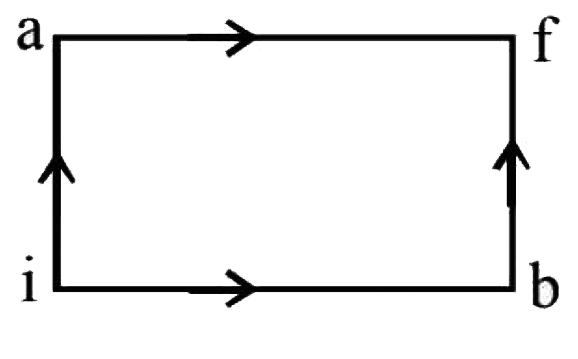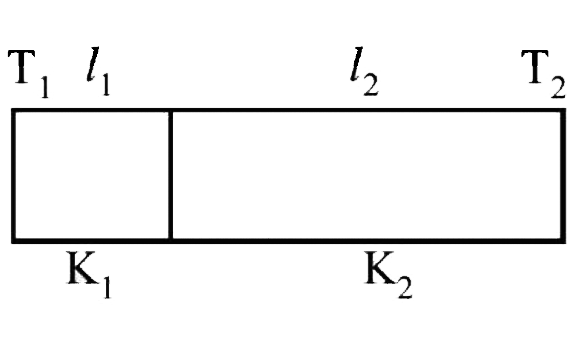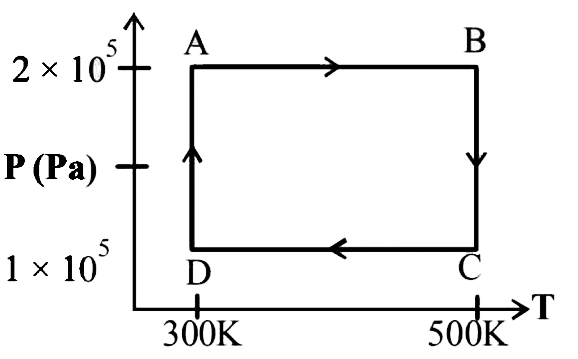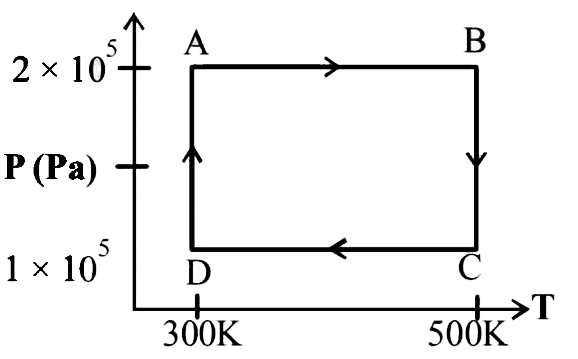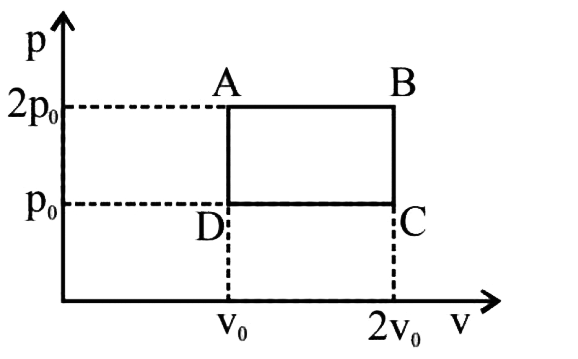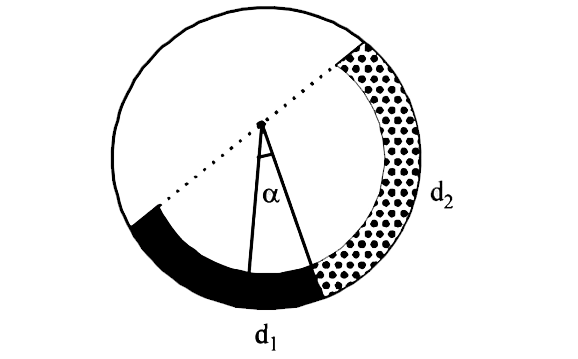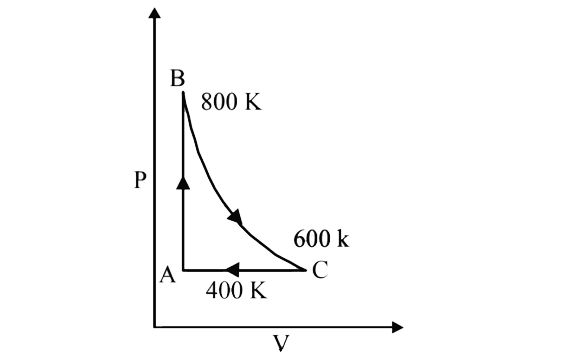JEE Main And Advanced from SUNIL BATRA 41 YEARS IITJEE PHYSICS (HINGLISH) HEAT AND THERMODYNAMICS for Class 11
| Class 11 | PHYSICS |
| Chapter | HEAT AND THERMODYNAMICS |
| SUNIL BATRA 41 YEARS IITJEE PHYSICS (HINGLISH) | JEE Main And Advanced |
| Medium | English |
| Academic Year | 2023-2024 |
Question 5
The earth receives at its surface radiation from the sun at the rate of 1400Wm−2. The distance of the centre of the sun from the surface of the earth is 1.5×1011m and the radius of the sun is 7×108m. Treating the sun as a black body, it follows from the above data taht its surface temperature is ......KView SolutionQuestion 7
A point source of heat of power P is placed at the centre of a spherical shell of mean radius R. The material of the shell has thermal conductivity K. If the temperature difference between the outer and inner surface of the shell in not to exceed T, the thickness of the shell should not be less than .......View SolutionQuestion 9
A container of volume 1m3 is divided into two equal parts by a partition. One part has an ideal gas at 300K and the other part is vacuum. The whole system is thermally isolated from the surroundings. When the partition is removed, the gas expands to occupy the whole volume. Its temperature will now be .......View SolutionQuestion 10
An ideal gas with pressure P, volume V and temperature T is expanded isothermically to a volume 2V and a final pressure Pi, If the same gas is expanded adiabatically to a volume 2V, the final pressure Pa. The ratio of the specific heats of the gas is 1.67. The ratio PaP1 is .......View SolutionQuestion 11
Two metal cubes A and B of same size are arranged as shown in Figure. The extreme ends of the combination are maintened at the indicated temperatures. The arrangement is thermally insulted. The coefficients of thermal conductivity of A and B are 300W/m∘Cand200W/m∘C, respectively. After steady state is reached the temperature t of the interface will be ......
 View Solution
View SolutionQuestion 12
A ring shaped tube contain two ideal gases with equal masses and relative molar masses M1=32andM2=28.
The gases are separated by one fixed partion and another movable stopper S which can move freely without friction inside the ring. The angle α as shown in the figure is ...... degrees.
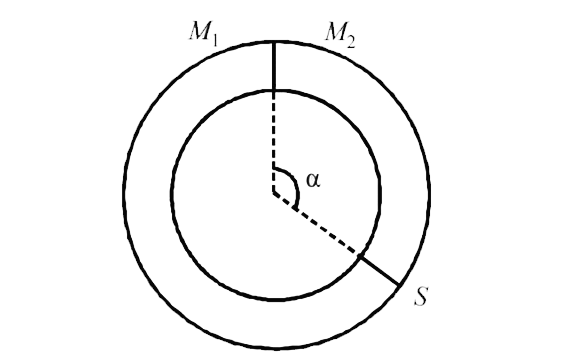 View Solution
View SolutionQuestion 24
A wall has two layers A and B, each made of different material. Both the layers have the same thickness. The thermal conductivity of the meterial of A is twice that of B . Under thermal equilibrium, the temperature difference across the wall is 36∘C. The temperature difference across the layer A is View SolutionQuestion 28
Three rods of identical area of cross-section and made from the same metal from the sides of an isosceles triangle. ABC, right angled at B. The points A and B are maintained at temperatures T and √2T RESPECTIVELY. In the steady state the temperature of the point C is TC.
Assuming that only heat conduction takes place , TCT is equal to View SolutionQuestion 29
Two metallic spheres S1andS2 are mode of the same material and have got identical surface finish. The mass of S1 is thrice that of S2. Both the spheres are heated to the same high temperature and placed in the same room having lower temperature but are thermally insulted from each other. The ratio of the initial rate of coiling of S1 to that of S2 isView SolutionQuestion 36
A monatomic ideal gas, initially at temperature T1, is enclosed in a cylinder fitted with a frictionless piston. The gas is allowed to expand adiabatically to a temperature T2 by releasing the piston suddenly. If L1andL2 are the length of the gas column before expansion respectively, then T1T2 is given byView SolutionQuestion 44
When a block of iron in mercury at 0∘C, fraction K1of its volume is submerged, while at the temperature 60∘C, a fraction K2 is seen to be submerged. If the coefficient of volume expansion of iron is γFe and that of mercury is γHg, then the ratio (K1)/(K2) can be expressed as View SolutionQuestion 49
Two rods, one of aluminium and the other made of steel, having initial length l1andl2 are connected together to from a single rod of length l1+l2. The coefficients of linear expansion for aluminium and steel are αaandαs and respectively. If the length of each rod increases by the same amount when their temperature are raised by t0C, then find the ratio l1/(l1+l2) View SolutionQuestion 51
2kg of ice at 20C∘ is mixed with 5kg of water at 20C∘ in an insulating vessel having a negligible heat capacity. Calculate the final mass of water remaining in the container. It is given that the specific heats of water & ice are 1kcal/kg/∘C0.5
kcal/kg/∘C while the latent heat of fusion of ice is 80kcal/kgView SolutionQuestion 61
Water is filled up to a height h in a beaker of radiys R as shown in the figure. The density of water is ρ, the surface tension of water is T and the atmospheric pressure is P0. Consider a vertical section ABCD of the water column through a diameter of the beaker. The force on water on one side on this section by water on the other side of this section has magnitude
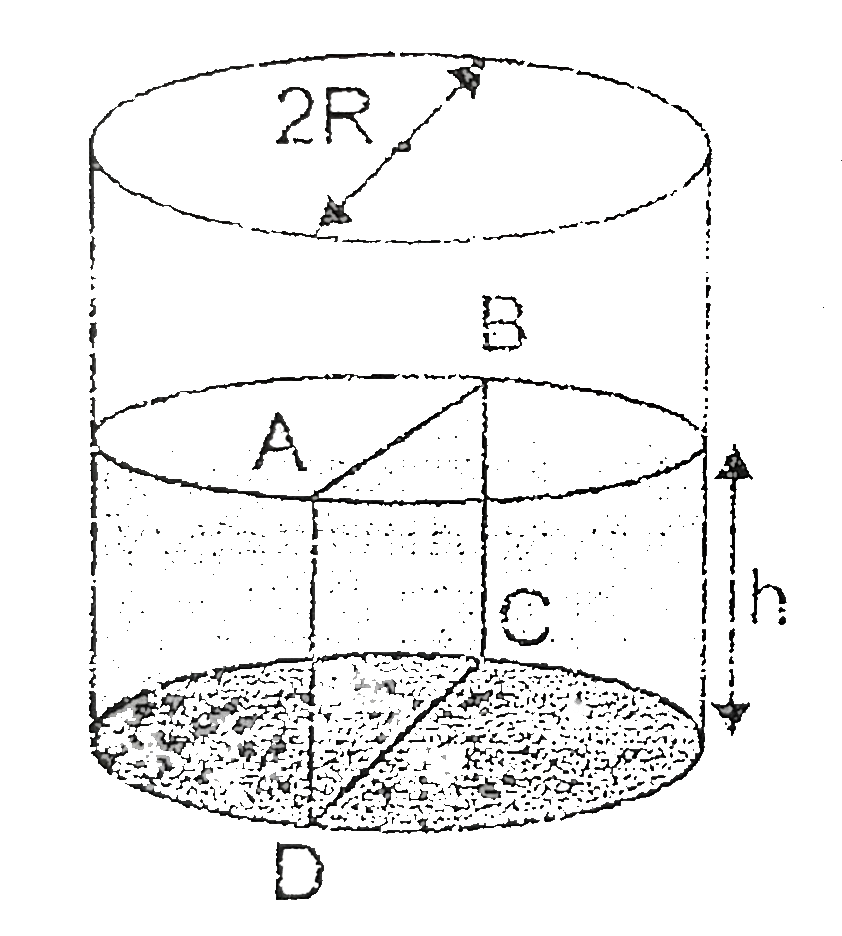 View Solution
View SolutionQuestion 66
Two moles of ideal helium gas are in a rubber balloon at 30∘C. The balloon is fully expandable and can be assumed to require no energy in its expansion. The temperature of the gas in the balloon is slowly changed to 35∘C. The amount of heat required in raising the temperature is nearly (take R
=8.31J/mol.K)View SolutionQuestion 67
Two rectangular blocks, having identical dimensions, an be arranged either in configuration-I or in configuration-II as shown in the figure. One of the blocks has thermal conductivity k and the other 2k. The temperature difference between the ends along the x-axis is the same in both the configurations. It takes 9s to transport a certain amount of heat from the hot end to the cold end in the configuration-I. The time to transport the same amount of heat in the configuration-II is
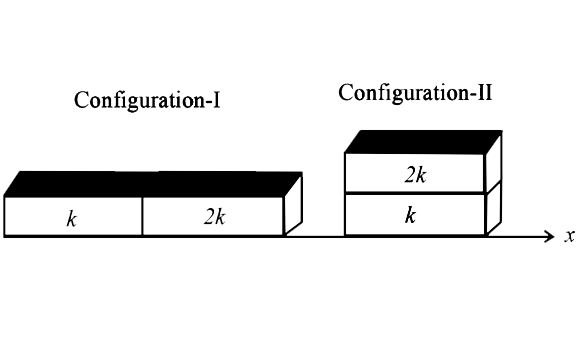 View Solution
View SolutionQuestion 69
Parallel rays of light of intensity I=912WM−2 are incident on a spherical black body kept in surroundings of temperature 300K. Take Stefan-Boltzmann constant σ=5.7×10−8
Wm−2K−4 and assume that the energy exchange with the surroundings is only through radiation. The final steady state temperature of the black body is close to View SolutionQuestion 70
A water cooler of storages capacity 120 liters can cool water at a constant rate of P watts. In a closed circulation system (as shown schematically in the figure), the water from the cooler is used to cool an external device that generates constantly 3kW of heat (thermal load). The temperature of water fed into the device cannot exceed 30∘C and the entire stored 120 liters of water is initially cooled to 10∘C. The entire system is thermally insulated. The minimum value of P ( in watts) for which the device can be operated for 3hours is
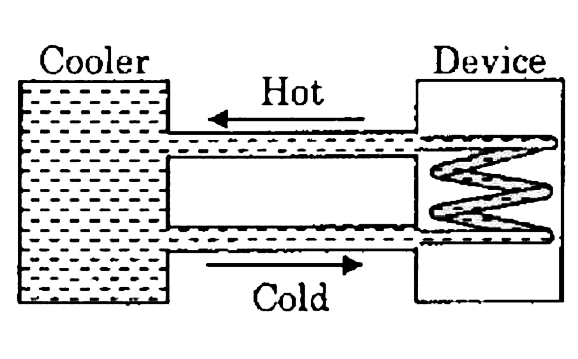
(Specific heat of water is 4.2kJkg−1K−1 and the density of water is 1000kgm−3)View SolutionQuestion 71
A gas is enclosed in a cylinder with a movable frictionless piston. Its initial thermodynamic state at pressure Pi=105 Pa and volume Vi=10−3m3 changes to a final state at Pf=(1/32)×105PaandVf=8×10−3m3 in an adiabatic quasi-static process, such that P3V3=constant. Consider another thermodynamic process that brings the system form the same initial state to the same final state in two steps: an isobaric expansion at Pi followed by an isochoric (isovolumetric ) process at volume Vr. The amount of heat supplied to the system i the two-step process is approximatelyView SolutionQuestion 72
The ends Q and R of two thin wires, PQ and RS, are soldered (joined) together. Initially each of the of wire has a length of 1m at 10∘C. Now the end P is maintained at 10∘C, while the ends S is heated and maintained at 400∘C. The system is thermally insultated from its surroundings. If the thermal conductivity of wire PQ is twice that of the wire RS and the coefficient of linear thermal expansion of PQ is 1.2×10−5K−1, the change in length of the wire PQ is View SolutionQuestion 76
A cylinder of radius R made of a material of thermal conductivity K1 is surrounded by a cylinderical shell of inner radius R and outer radius 2R made of a material of thermal conductivity K2. The two ends of the combined system are maintained at two different temperatures. There is no loss of heat across the cylindrical surface and the system is in steady state. The effictive thermal conductivity of the system is View SolutionQuestion 79
Three closed vessels A, B and C are at the same temperature T and contain gasses which obey the Maxwellian distribution of velocities. Vessel A contain only O2andN2. If the average speed of the O2 molecules in vessel A is v1 that of the N2 molecules in vessel B us v2, the average speed of the O2 molecules in vessel C is View SolutionQuestion 81
Two bodies A and B ahave thermal emissivities of 0.01 and 0.81 respectively. The outer surface areas of the two bodies are the same. The two bodies emit total radiant power of the same rate. The wavelength λB corresponding to maximum spectral radiancy in the radiation from B shifted from the wavelength corresponding to maximum spectral radiancy in the radiation from A, by 1.00μm. If the temperature of A is 5820K:View SolutionQuestion 84
Two cylinders A and B fitted with pistons contain equal amounts of an ideal diatomic gas at 300K. The piston of A is free to move, while that B is held fixed. The same amount of heat is given to the gas in each cylinder. If the rise in temperature of the gas in A is 30K, then the rise in temperature of the gas in B is View SolutionQuestion 88
Two identical containers A and B with frictionless pistons contain the same ideal gas at the same temperature and the same velocity V. The mass of the gas in A is mA, and that in B is mB. The gas in each cylinder is now allowed to expand isothermally to the same final volume 2V. The changes in the pressure in A and B are found to be ΔPand1.5ΔP respectively. ThenView SolutionQuestion 95
A composite block is made of slabs A,B,C,D and E of different thermal conductivities (given in terms of a constant K and sizes (given in terms of length, L) as shown in the figure. All slabs are of same width. Heat 'Q' flows only from left to right through the blocks. Then in steady state
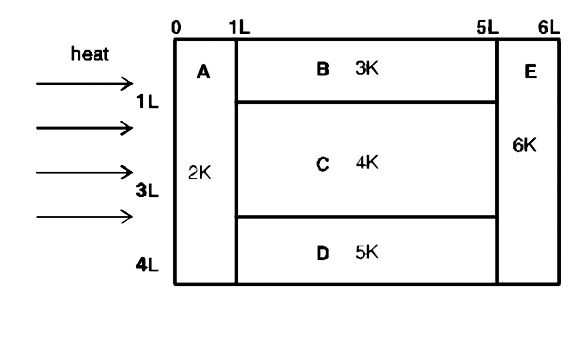 View Solution
View SolutionQuestion 96
The figure below shows the variation of specific heat capacity (C) of a solid as a function of temperature (T). The temperature is increased continuousely form 0 to 500K at a constant rate. Ignorign any volume change, the following statement (s) is (are) correct to a reasonable approximation.
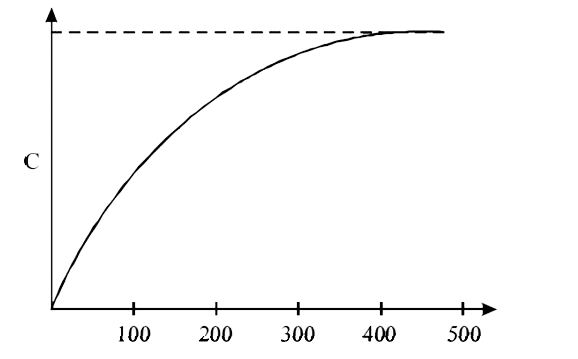 View Solution
View SolutionQuestion 98
An ideal monoatomic gas is confined in a horizontal cylinder by a spring loaded piston (as shown in the figure). Initially the gas is at temperature T1, pressure P1 and volume V1and the spring is in its relaxed state. The gas is tehn heated very slowly to temperature T2,pressure P2and volume V2. During this process the piston moves out by a distance x. Ignoring the friction between the piston and the cylinder, the correct statement (s) is (are)
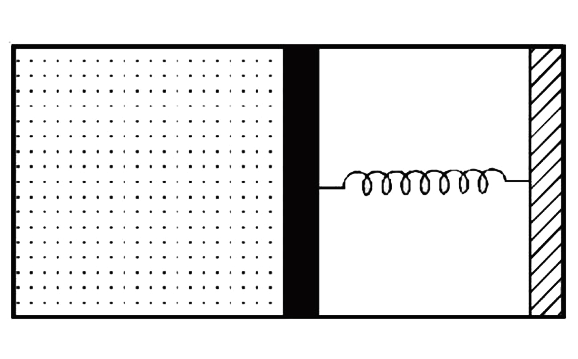 View Solution
View SolutionQuestion 100
Three rods of material X and three rods of material Y are connected as shown in the figure. All the rods are of identical length and cross-sectional area. If the end A is maintained at 60∘C and the junction E at 10∘C. Calculate the temperature of the junction B, C and D. The thermal conductivity of X is 0.92cal/sec−cm∘C and that of Y is 0.46cal/sec−cm−∘C.
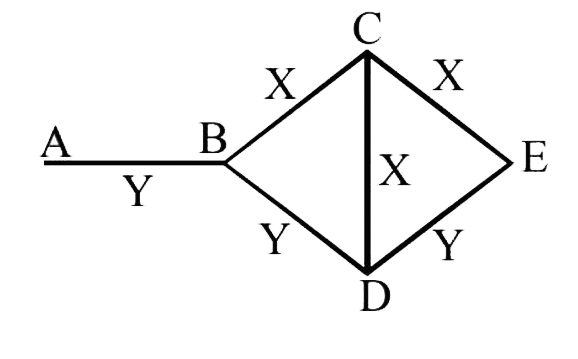 View Solution
View SolutionQuestion 102
A solid material is supplied with heat at a constant rate. The temperature of the material is changing with the heat input as shown in the graph in figure. Study the graph carefully and answer the following questions:
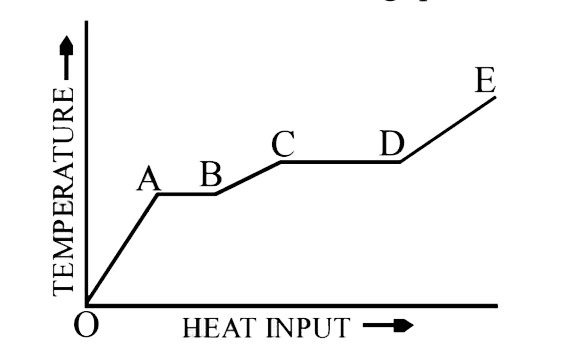
(i) What do the horizontal regions AB and CD represent?
If CD is equal to 2AB, what do you infer?
What does the slope of DE represents?
The slope of OAgtthe slope of BC. What does this indicate?View SolutionQuestion 103
A jar contains a gas and a few drops of water at absolute temperture T1. The pressure in the jar is 830mm of mercury. The temperature of the jar is reduced by 1%. The saturation vapour pressures of water at the two temperatures are 30mm of mercury and 25mm of mercury. Calculate the new pressure in the jar. View SolutionQuestion 105
A lead bullet just melts when stopped by an obstacle. Assuming that 25 per cent of the heat is absorbed by the obstacle, find the velocity of the bullet if its initial temperature is 27∘C. (Melting point of lead=327∘C, specific heat of lead =0.03calories/gm/∘C, latent jeat of fusion of lead=6calories/gm,J=4.2joe–s/calorie).View SolutionQuestion 108
1g mole of oxygen at 27∘C and 1 atmosphere pressure is enclosed in a vessel.
(a) Assuming the molecules to be moving with vrms, find the number of collisions per second which the molecules make with one square metre area of the vessel wall.
(b) The vessel is next thermally insulated and moves with a constant speed v0. It is then suddenly stoppes. The process results in a rise of temperature of the gas by 1∘C. Calculate the speed v0.[k=1.38×10−23J/K and NA=6.02×1023/mol].View SolutionQuestion 109
A rectangualr box (shown in figure) has a movable and smooth portition which can slide along the length of the box. Both chambers contains 1 mole of monoatomic gas (γ=53) at a pressure walls of box and partition are thermally insulated. Due to heating, gas in left chamber expands until pressure in both chambers become 32P0 determine
(a) The final temperature of gas in each chamber
(b) The work done by the gas in the right chamber.
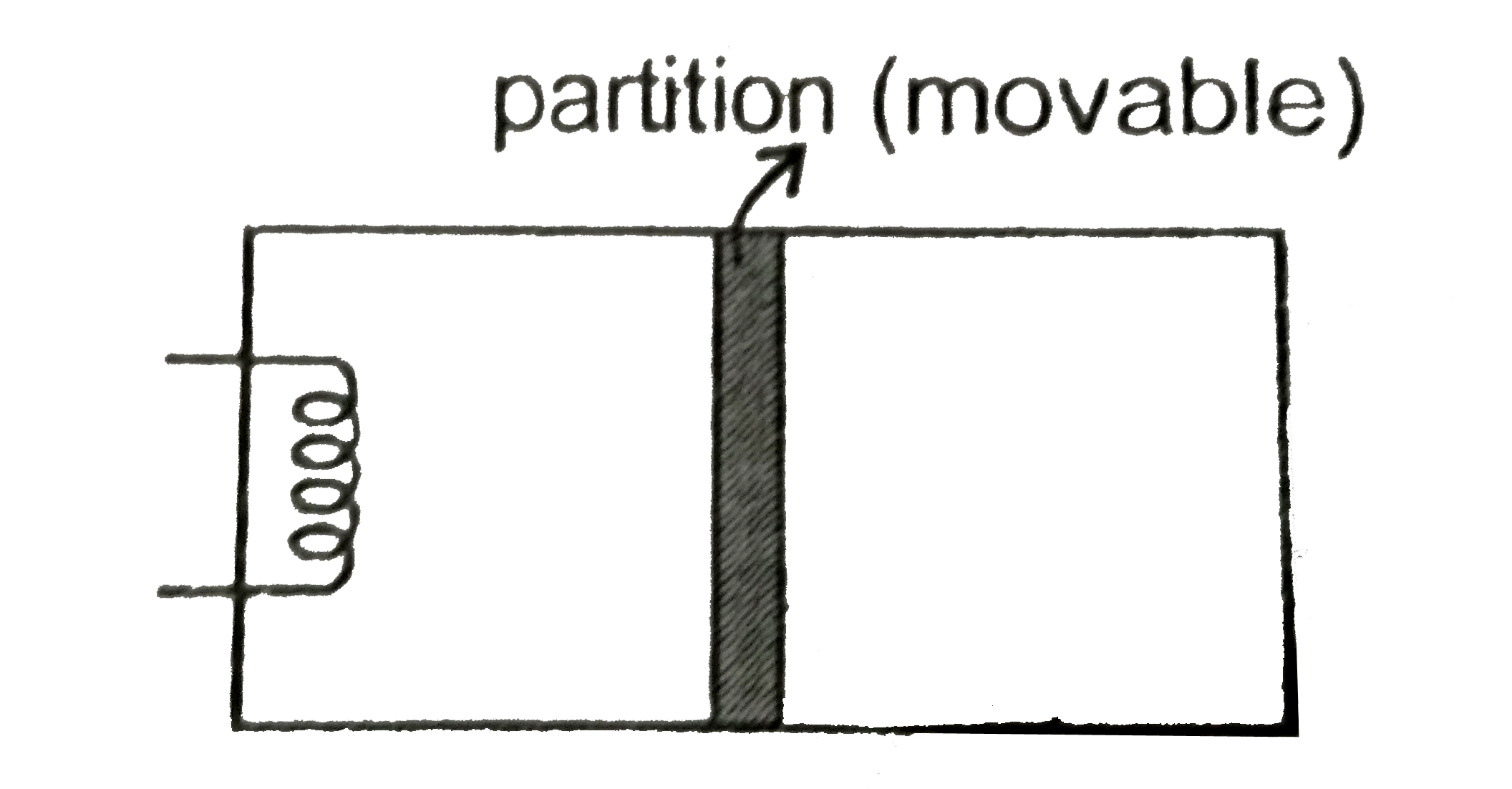 View Solution
View SolutionQuestion 110
Two glass bulbs of equal volume are connected by a narrow tube and are filled with a gas at 0∘C and a pressure of 76cm of mercury. One of the bulbs is then placed in melting ice and the other is placed in a water bath maintained at 62∘C. What is the new value of the pressure inside the bulbs? The volume of the connecting tube is negligible.View SolutionQuestion 111
A thin tube of uniform cross section is sealed at both ends. It lies horizontally, the middle 5cm containing mercury and the parts on its two sides containing air at the same pressure p. When the tube is held at and angle of 60∘ with the vertical, the length of the air column above and below the mercury pellet are 46cm and 44.5cm respectively. Calculate the pressure in centimeters of mercury, The temperature of the system is kept at 30∘C.View SolutionQuestion 112
An ideal gas has a specific heat at constant pressure CP=5R2. The gas is kept in a closed vessel of volume 0.0083m3, at a temperature of 300K and a pressure of 1.6×106N/m2. An amount of 2.49×104 Joules of heat energy is supplied to the gas. Calculate the final temperature and pressure of the gas. View SolutionQuestion 113
Two moles of helium gas(λ=5/3) are initially at temperature 27∘C and occupy a volume of 20 litres. The gas is first expanded at constant pressure until the volume is doubled. Then it undergoes an adiabatic change until the temperature returns to its initial value.
(i) Sketch the process on a p-V diagram.
(ii) What are the final volume and pressure of the gas?
(iii) What is the work done by the gas ?View SolutionQuestion 114
An ideal monatomic gas is confined in a cylinder by a spring-loaded piston of cross-section 8.0×10−3m2. Initially the gas is at 300K and occupies a volume of 2.4×10−3m3 and the spring is in its relaxed (unstretched, unompressed) state, fig. The gas is heated by a small electric heater until the piston moves out slowly by 0.1m. Calculate the final temperature of the gas and the heat supplied (in joules) by the heater. The force constant of the spring is 8000N/m, atmospheric pressure is 1.0×105Nm−2. The cylinder and the piston are thermally insulated. The piston is massless and there is no friction between the piston and the cylinder. Neglect heat loss through lead wires of the heater. The heat capacity of the heater coil is negligible. Assume the spring to be massless.
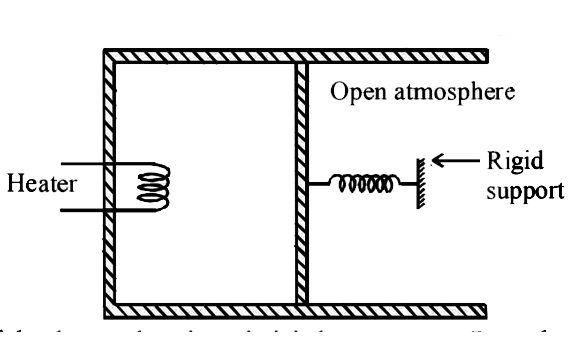 View Solution
View SolutionQuestion 115
An ideal gas having initial pressure P, volume V and temperature T is allowed to expands adiabatically until its volume becomes 5.66V while its temperature falls to T/2.
(i) How many degrees of freedom do the gas molecules have?
Obtain the work done by the gas during the expansion as a function of the initial pressure P and volume V.View SolutionQuestion 116
Three moles of an ideal gas (Cp=72R) at pressure, PA and temperature TA is isothermally expanded to twice its initial volume. It is then compressed at constant pressure to its original volume. Finally gas is compressed at constant volume to its original pressure PA.
(a) Sketch P-V and P-T diagrams for the complete process.
(b) Calculate the net work done by the gas, and net heat supplied to the gas during the complete process.View SolutionQuestion 118
One mole of a monoatomic ideal gas is taken through the cycle shown in Fig:
A→B: adiabatic expansion
B→C: cooling at constant volume
C→D: adiabatic compression
D→A: heating at constant volume

The pressure and temperature at A,B,etc. are denoted by PA,TA,PB,TBetc. respectively. Given that TA=1000K, PB=(2/3)PAandPC=(1/3)PA, calculate the following quantities:
(i) The work done by the gas in the process A→B
(ii) The heat lost by the gas in the process B→C.
(iii) The temperature TD. [Given :(2/3)2/5=0.85]View SolutionQuestion 119
An ideal gas is taken through a cyclic thermodynamic process through four steps. The amounts of heat involved in these steps are Q1=5960J,Q2=−5585J,Q3=−2980JandQ4=3645J, respectively. The corresponding quantities of work involved are W1=2200J,W2=−825J,W3=−1100JandW4 respectively.
(1) Find the value of W4.
(2) What is the efficiency of the cycle View SolutionQuestion 120
A closed container of volume 0.02m3contains a mixture of neon and argon gases, at a temperature of 27∘C and pressure of 1×105Nm−2. The total mass of the mixture is 28g. If the molar masses of neon and argon are 20and40gmol−1 respectively, find the masses of the individual gasses in teh container assuming them to be ideal (Universal gas constant R=8.314J/mol−K).View SolutionQuestion 121
A gaseous mixture enclosed in a vessel of volume V consists of one mole of a gas A with γ=(Cp/Cv)=5/3 and another gas B with γ=7/5 at a certain temperature T. The relative molar masses of the gasses A and B are 4 and 32, respectively. The gases A and B do not react with each other and are assumed to be ideal. The gaseous mixture follows the equation PV19/13=constant, in adiabatic processes.
(a) Find the number of moles of the gas B in the gaseous mixture.
(b) Compute the speed of sound in the gaseous mixture at T=300K.
(c) If T is raised by 1K from 300K, find the % change in the speed of sound in the gaseous mixture.
(d) The mixtrue is compressed adiabatically to 1/5 of its initial volume V. Find the change in its adaibatic compressibility in terms of the given quantities.View SolutionQuestion 124
One mole of a diatomic ideal gas (γ=1.4) is taken through a cyclic process starting from point A. The process A→B is an adiabatic compression, B→C is isobaric expansion, C→D is an adiabatic expansion, and D→A is isochoric. The volume ratios are VA/VB=16andVC/VB=2 and the temperature at A is TA=300K. Calculate the temperature of the gas at the points B and D and find the efficiency of the cycle. View SolutionQuestion 125
The apparatus shown in the figure consists of four glass columns connected by horizontal section. The height of two central column B and C are 49 cm each. The two outer columns A and D are open to the temperature. A and C are maintained at a temperature of 95∘C while the columns B and D are maintained at 5∘C. The height of the liquid in A and D measured from the base the are 52.8 cm and 51cm respectively. Determine the coefficient of thermal expansion of the liquid
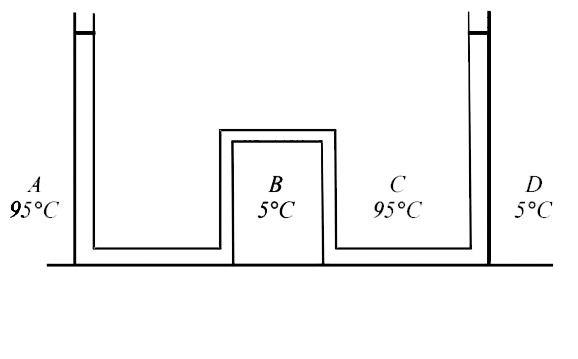 View Solution
View SolutionQuestion 126
One mole of an ideal monatomic gas is taken round the cyclic process ABCA as shown in figure. Calculate
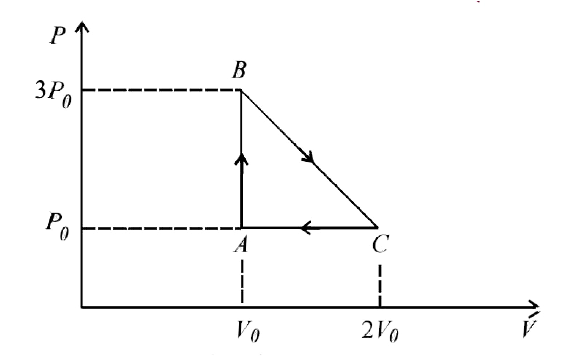
(a) the work done by the gas.
(b) the heat rejected by the gas in the path CA and the heat absorbed by the gas in the path AB,
(c) the net heat absorbed by the gas in the path BC,
(d) the maximum temperature attained by the gas during the cycle. View SolutionQuestion 127
A solid body X of heat capacity C is kept in an atmosphere whose temperature is TA=300K. At time t=0 the temperature of X is T0=400K. It cools according to Newton's law of cooling. At time t1, its temperature is found to be 350K. At this time (t1), the body X is connected to a large box Y at atmospheric temperature is T4, through a conducting rod of length L, cross-sectional area A and thermal conductivity K. The heat capacity Y is so large that any variation in its temperature may be neglected. The cross-sectional area A of hte connecting rod is small compared to the surface area of X. Find the temperature of X at time t=3t1.View SolutionQuestion 128
Two moles of an ideal monatomic gas, initially at pressure p1 and volume V1, undergo an adiabatic compression until its volume is V2. Then the gas is given heat Q at constant volume V2.
(i) Sketch the complete process on a p-V diagram.
(b) Find the total work done by the gas, the total change in its internal energy and the final temperature of the gas. [Give your answer in terms of p1,V1,V2,QandR]View SolutionQuestion 129
Two moles of an ideal monatomic gas is taken through a cycle ABCA as shown in the P-T diagram. During the process AB , pressure and temperature of the gas very such that PT=Constant. It T1=300K, calculate
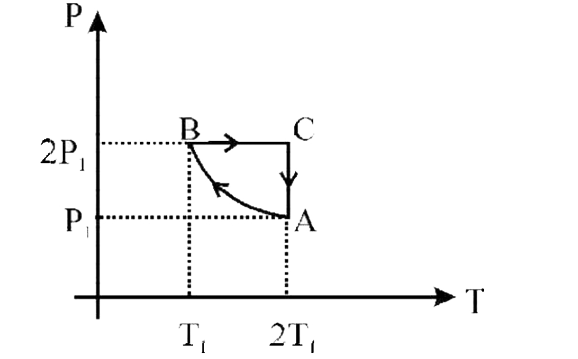
(a) the work done on the gas in the process AB and
(b) the heat absorbed or released by the gas in each of hte processes. Give answer in terms of the gas constant R.View SolutionQuestion 130
An ice cube of mass 0.1kg at 0∘C is placed in an isolated container which is at 227∘C. The specific heat S of the container varies with temperature T according to the empirical relation S=A+BT, where A=100cal/kg−KandB=2×10−2cal/kg−K2. If the final temperature of the container is 27∘C, determine the mass of the container. (Latent heat of fusion of water =8×104cal/kg, Specific heat of water=103cal/kg−K).View SolutionQuestion 131
A monoatomic ideal gas of two moles is taken through a cyclic process starting from A as shown in figure. The volume ratios are VBVA=2andVDVA=4. If the temperature TA at A is 27∘C.
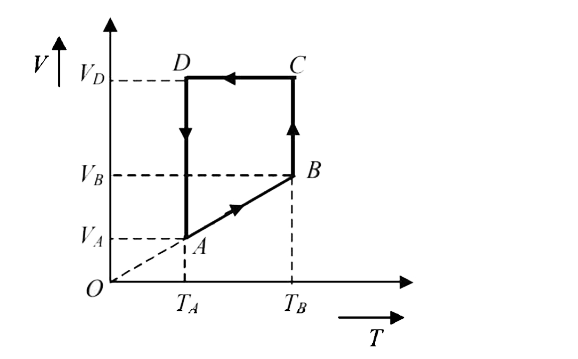
Calculate,
(a) the temperature of the gas at point B,
(b) heat absorbed or released by the gas in each process,
(c) the total work done by the gas during the complete cycle. Express your answer in terms of the gas constant R.View SolutionQuestion 132
A cubical box of side 1 meter contains heluim gas (atomic weight 4) at a pressure of 100N/m2. During and obervation time of 1 second, an atom travelling with the root-mean-square speed parallel to one of the edges of the cube, was found to make 500 hits with a particular wall, without any collision with other atoms. Take R=253Jmo≤−Kandk=1.38×10−23J/K
(a) Evalute the temperature of the gas.
(b) Evalute the average kinetic energy per atom.
(c) Evalute the total mass of helium gas in the box.View SolutionQuestion 134
Hot oil is circulated thorugh an insulated container with a wooden lid at the top whose conductivity K=0.149J/(m−∘C−sec), thickness t=5mm,emissivity=0.6 Temperature of the top of the lid is maintaining at Tl=127∘C. If the ambient temperature Ta=27∘C.
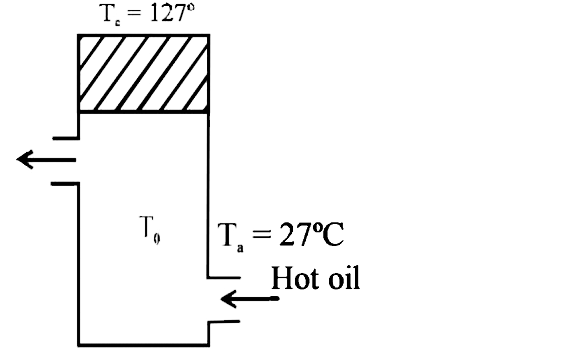
Calculate:
(a) rate of heat loss per unit area due to radiation from the lid.
(b) temperature of the oil. (Givenσ=173×10−8Wm−2K−4)View SolutionQuestion 135
A diatomic gas is enclosed in a vessel fitted with massless movable piston. Area of cross section of vessel is 1m2. Initial height of the piston is 1m (see the figure). The initial temperature of the gas is 300K. The temperature of the gas is increased to 400K, keeping pressure constant, calculate the new height of the piston. The piston is brought to its initial position with no heat exchange. Calculate the final temperature of the gas. You can leave answer in fraction.
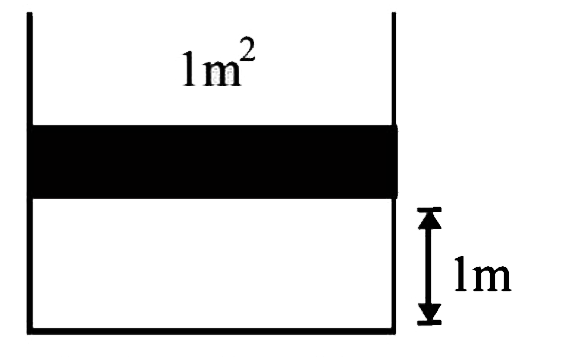 View Solution
View SolutionQuestion 137
A cylinder rod of length 1, thermal conductivity K and area of cross section A has one end in the furnace at temperature T1 and the other end in surrounding at temperature T2. Surface of the rod exposed to the surrounding has emissivity e. Also T2=Ts+ΔTandTs>>ΔT. If T1−Ts∝ΔT,find the proportionality constant.
 View Solution
View SolutionQuestion 138
A cubical block of co-efficient of linear expansion αs is submerged partially inside a liquid of co-efficient of volume expansion γl. On increasing the temperature of the system by ΔT, the height of the cube inside the liquid remains unchanged. Find the relation between αsandγl. View SolutionQuestion 139
A cylinder of mass 1kg is given heat of 20,000J at atmospheric pressure. If initially the temperature of cylinder is 20∘C, find
(a) final temperature of the cylinder.
(b) work done by the cylinder.
(c) change in internal energy of the cylinder
(Given that specific heat of cylinder=400Jkg−1^∘C−1, Atmospheric pressure= 105N/m2 and Density of cylinder=9000kg/m3)View SolutionQuestion 141
A fixed thermally conducting cylinder has a radius R and height L0. The cylinder is open at ita bottom and has a small hole at its top. A piston of mass M is held at a distance L from the top surface, as shown in the figure. The atmospheric pressure is P0.
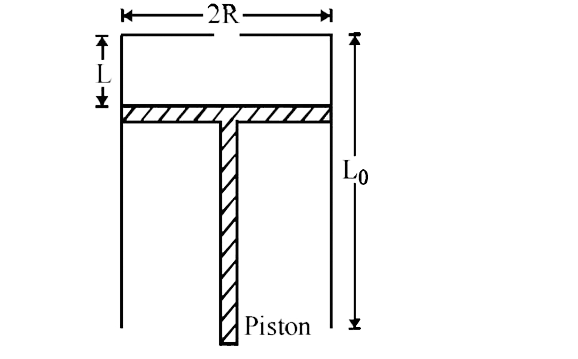
The piston is now pulled out slowly and held at a distance 2L from the top. The pressure in the cylinder between its top and the piston will then be View SolutionQuestion 142
A fixed thermally conducting cylinder has a radius R and height L0. The cylinder is open at ita bottom and has a small hole at its top. A piston of mass M is held at a distance L from the top surface, as shown in the figure. The atmospheric pressure is P0.
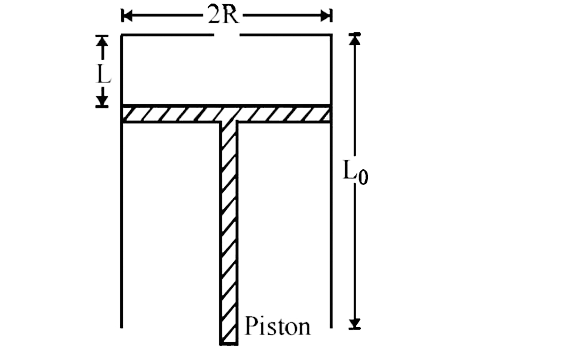
While the piston is at a distance 2L from the top, the hole at the top is sealed. The piston is then released, to a position where it can stay in equilibrium. In this condition, the distance of the piston from the top is View SolutionQuestion 143
A fixed thermally conducting cylinder has a radius R and height L0. The cylinder is open at ita bottom and has a small hole at its top. A piston of mass M is held at a distance L from the top surface, as shown in the figure. The atmospheric pressure is P0.
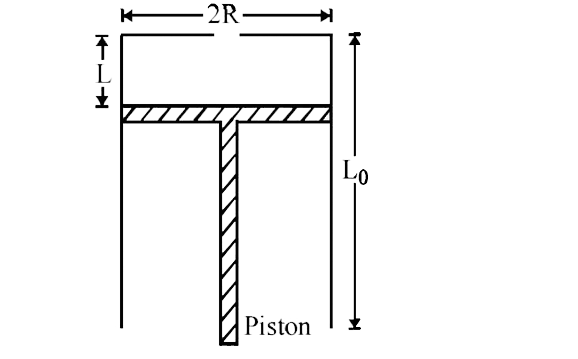
The piston is taken completely out of the cylinder. The hole at the top is sealed. A water tank is brought below the cylinder and put in a position so that the water surface in the tank is at the same level as the top of the cylinder as shown in the figure. The density of the water is ρ. In equilibrium, the height H of the water coulmn in the cylinder satisfies
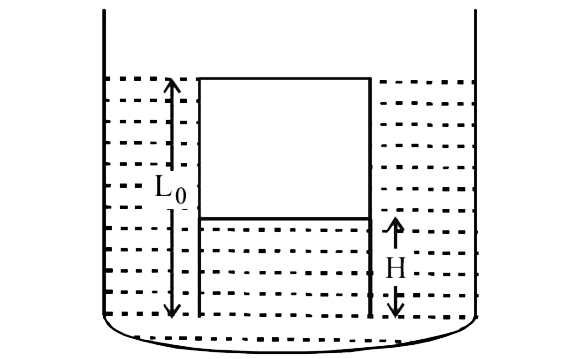 View Solution
View SolutionQuestion 144
A small spherical monoatomic ideal gas bubble (γ=5/3) is trapped inside a liquid of density ρ (see figure). Assume that the bubble does not exchange any heat with the liquid. The bubble contains n moles of gas. The temperature of the gas when the bubble is at the bottom is T0, the height of the liquid is H and the atmospheric pressure P0 (Neglect surface tension).
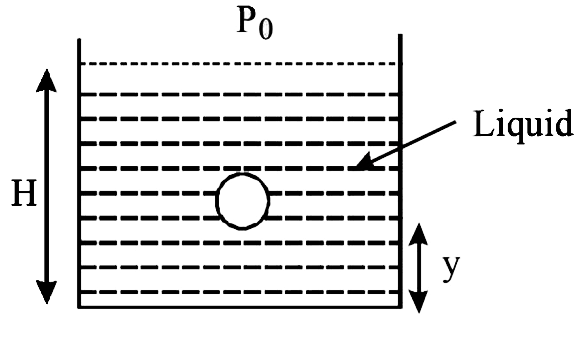
As the bubble moves upwards, besides the buyoncy force the following forces are acting on it View SolutionQuestion 145
A small spherical monoatomic ideal gas bubble (γ=5/3) is trapped inside a liquid of density ρ (see figure). Assume that the bubble does not exchange any heat with the liquid. The bubble contains n moles of gas. The temperature of the gas when the bubble is at the bottom is T0, the height of the liquid is H and the atmospheric pressure P0 (Neglect surface tension).
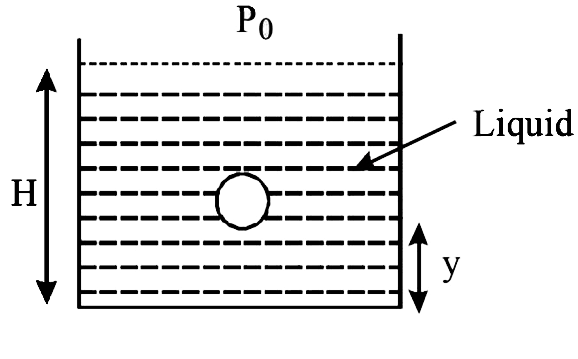
When the gas bubble is at a height y from the bottom, its temperature is-View SolutionQuestion 146
A small spherical monoatomic ideal gas bubble (γ=5/3) is trapped inside a liquid of density ρ (see figure). Assume that the bubble does not exchange any heat with the liquid. The bubble contains n moles of gas. The temperature of the gas when the bubble is at the bottom is T0, the height of the liquid is H and the atmospheric pressure P0 (Neglect surface tension).

The buyoncy force acting on the gas bubble is (Assume R is the universal gas constant)View SolutionQuestion 147
In the figure, a container is shown to have a movable (without friction) piston on top. The container and the piston are all made of perfectly insulated material allowing no heat transfer between outside and inside the container. The container is divided into two compartments by a rigid partition made of a thermally conducting material that allows slow transfer of heat. The lower compartment of the container is filled with 2 moles of an ideal monatomic gas at 700K and the upper compartment is filled with 2 moles of an ideal diatmoic gas at 400K. The heat capacities per mole of an ideal monatomic gas are CV=32R,CP=52R, and those for an ideal diatomic gas are CV=52R,CP=72R,
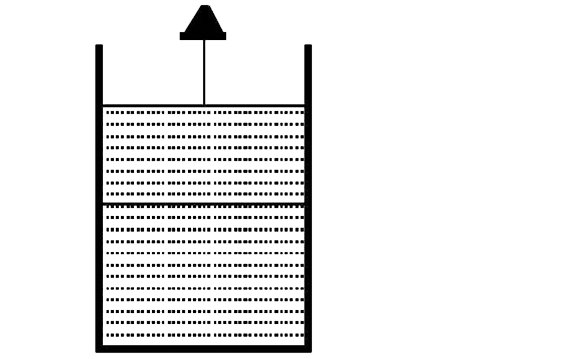
Consider the partition to be rigidly fixed so that it does not move. When equilibrium is achieved, the final temperature of the gasses will be View SolutionQuestion 148
In the figure, a container is shown to have a movable (without friction) piston on top. The container and the piston are all made of perfectly insulated material allowing no heat transfer between outside and inside the container. The container is divided into two compartments by a rigid partition made of a thermally conducting material that allows slow transfer of heat. The lower compartment of the container is filled with 2 moles of an ideal monatomic gas at 700K and the upper compartment is filled with 2 moles of an ideal diatmoic gas at 400K. The heat capacities per mole of an ideal monatomic gas are CV=32R,CP=52R, and those for an ideal diatomic gas are CV=52R,CP=72R,
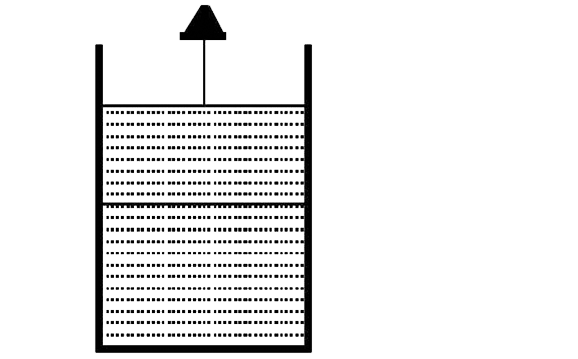
Now consider the partition to be free to move without friction so that the pressure of gasses in both compartments is the same. The total work done by the gases till the time they achives equilibrium will be View SolutionQuestion 149
Statement-1: The total translational kenetic energy of fall the molecules of a given mass of an ideal gas is 1.5 times the product of its pressure and its volume because.
Statement-2: The molecules of a gas collide with each other and the velocities of the molecules change due to the collision. View SolutionQuestion 150
A metal rod AB of length 10x has its one end A in ice at 0∘C, and the other end B in water at 100∘C. If a point P one the rod is maintained at 400∘C, then it is found that equal amounts of water and ice evaporate and melt per unit time. The latent heat of evaporation of water is 540cal/g and latent heat of melting of ice is 80cal/g. If the point P is at a distance of λx from the ice end A, find the value λ. [Neglect any heat loss to the surrounding.] View SolutionQuestion 151
A piece of ice (heat capacity=2100Jkg−1^∘C−1 and latent heat =3.36×105Jkg−1) of mass m grams is at −5∘C at atmospheric pressure. It is given 420J of heat so that the ice starts melting. Finally when the ice-water mixture is in equilibrium, it is found that 1gm of ice has melted. Assuming there is no other heat exhange in the process, the value of m is View SolutionQuestion 152
Two spherical bodies, A(radius 6cm) and B(radius 18cm) are at temperature T1andT2, respectively. The maximum intensity in the emission spectrum of A is at 500nm and in that of B is at 1500nm. Considering them to be black bodies, what will be the ratio of the rate of total energy radiated by A to that of B?View SolutionQuestion 154
Steel wire of length 'L' at 40∘C is suspended from the ceiling and then a mass 'm' is hung from its free end. The wire is cooled down from 40∘C→30∘C to regain its original length 'L'. The coefficient of linear thermal expansion of the steel is 10−5/∘C, Young's modulus of steel is 1011N/m2 and radius of the wire is 1mm. Assume that L>> diametere of the wire. Then the value of 'm' in kg is nearly View SolutionQuestion 155
A thermodynamic system is taken from an initial state I with internal energy Ui=−100J to the final state f along two different paths iaf and ibf, as schematically shown in the figure. The work done by the system along the pat af, ib and bf are Waf=200J,Wib=50JandWbf=100J respectively. The heat supplied to the system along the path iaf, ib and bf are Qiaf,Qib,Qbf respectively. If the internal energy of the system in the state b is Ub=200JandQiaf=500J, The ratio QbfQib is
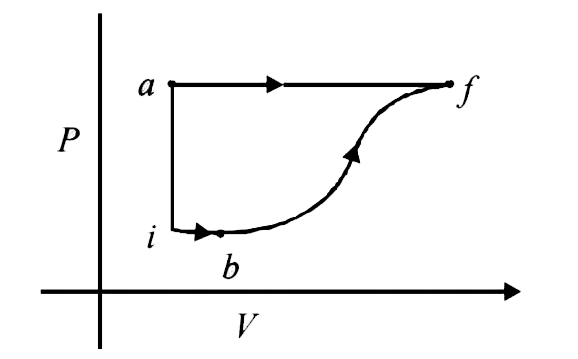 View Solution
View SolutionQuestion 157
A metal is heated in a furnace where a sensor is kept above the metal surface to read the power radiated (P) by the metal. The sensor has scale that displays log2,(P/P0), where P0 is constant. When the metal surface is at a temperature of 487∘C, the sensor shows a value 1. Assume that the emissivity of the metallic surface remains constant. What is the value displyed by the sensor when the temperature of the metal surface is raised to 2767∘C?View SolutionQuestion 178
The temperature of the two outer surfaces of a composite slab, consisting of two materails having coefficients of two materails having coefficients of termal conductivity K and 2K and thickness x and 4x, respectively, are T2andT1(T1>T1). The rate of heat transfer through the slab, in a steady state is (A(T2−T1)K2)f, with f equal to
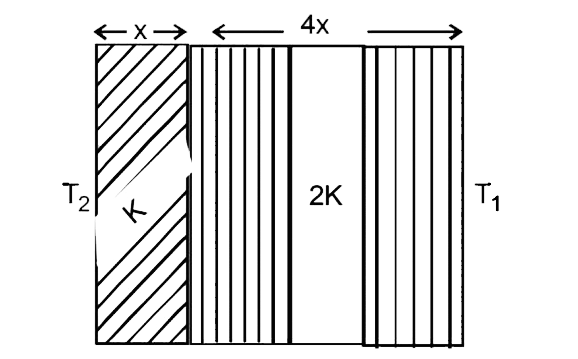 View Solution
View SolutionQuestion 185
Two rigid boxes containing different ideal gases are placed on a table. Box A contains one mole of nitrogen at temperature T0, while Box contains one mole of helium at temperature (73)T0. The boxes are then put into thermal contact with each other, and heat flows between them until the gasses reach a common final temperature (ignore the heat capacity of boxes). Then, the final temperature of the gasses, Tf in terms of T0 is View SolutionQuestion 192
An insulated container of gas has two chambers separated by an insulating partition. One of the chmabers has volume V1 and contains ideal gas at pressure P1 and temperature T1.The other chamber has volume V2 and contains ideal gas at pressure P2 and temperature T2. If the partition is removed without doing any work on the gas, the final equilibrium temperature of the gas in the container will be View SolutionQuestion 198
Statement-1: The temperature dependence of resistance is usually given as R=R0(1+αΔT). The resistance of a wire changes from 100Ω→150Ω when its temperature is increased from 27∘C→227∘C. This implies that α=2.5×10−3/∘C.
Statement 2: R=R0(1+αΔT) is valid only when the change in the temperature ΔT is small and ΔR=(R−R0)<<R0.View SolutionQuestion 204
A wooden wheel of radius R is made of two semicircular part . The two parts are held together by a ring made of a metal strip of cross sectional area S and length L. L is slightly less than 2πR. To fit the ring on the wheel, it is heated so that its temperature rises by ΔTand it just steps over the wheel. As it cools down to surrounding temperature, it process the semicircle parts together. If the coefficient of linear expansion of the metal is α, and it Young's modulus is Y, the force that one part of the wheel applies on the other part is :
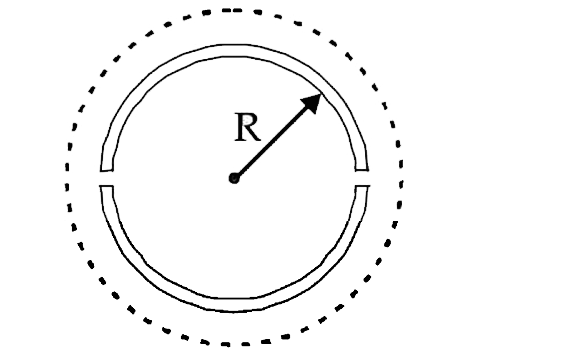 View Solution
View SolutionQuestion 212
Three rods of Copper, Brass and Steel are welded together to from a Y shaped structure. Area of cross-section of each rod =4cm2. End of copper rod is maintained at 100∘C where as ends of brass and steel are kept at 0∘C. Lengths of the copper, brass and steel rods are 46, 13 and 12 cm respectively. The rods are thermally insulated from surroundings excepts at ends. Thermal cunductivities of copper, brass and steel are 0.92, 0.26 and 0.12 CGS units respectively. Rate of heat flow through copper rod is : View SolutionQuestion 214
A solid body of constant heat capacity 1J/∘C is being heated by keeping it contact with reservoirs in two ways:
(i) Sequentially keeping in contact with 2 reservoirs such that each reservoir supplies same amount of heat.
(ii) Sequentially keeping in contact with 8 reservoir such that each reservoir supplies same amount of heat.
In both the cases body is brought from initial temperature 100C to final temperature 200∘C. Entropy change of the body in the tow cases respectively is : View SolutionQuestion 215
Consider a spherical shell of radius R at temperature T. The black body radiation inside it can be considered as an ideal gas of photons with internal energy per unit volume u=UV∝T4 and pressure P=13(UV). If the shell now undergoes an adiabatic expansion the relation between T and R is :View SolutionQuestion 219
An ideal gas under goes a quasi static, reversible process in whichh its molar heat capacity C remains constant. If during this process the relation of pressure P and volume V is given by PVn=constant, then n is given by (Here CPandCV are molar specific heat at constant pressur and constant volume, respectively):View Solution
